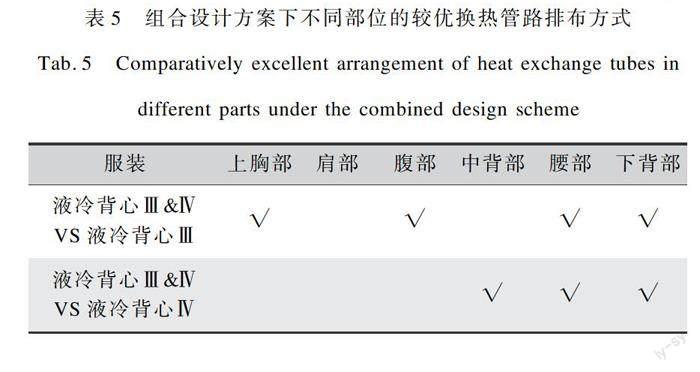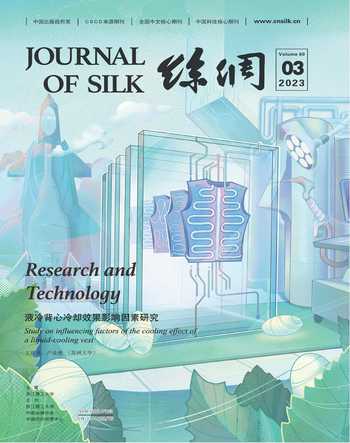液冷背心冷却效果影响因素研究
王欣欣 卢业虎



摘要: 针对战斗机飞行员低空大速度飞行时存在的热应激问题,文章研制了一款液冷背心。采用暖体假人实验对液冷背心的入口水温、换热管路参数及排布方式进行研究,探究入口水温、换热管路的排布密度、横纵向排布、管径大小对液冷服装制冷性能的影响。实验结果表明,液冷背心冷却能力随入口水温的降低而显著增加;换热管路排布密度显著影响液冷背心冷却效果;换热管路内外径、横纵向排布对液冷背心的冷却效果的影响不显著,但换热管路为3×5 mm、换热管路横向排布的液冷背心具有较优制冷能力;换热管路组合设计的液冷背心具有更好的冷却效果。研究结果可为液冷背心的科学设计提供参考。
关键词: 液冷背心;热应激;出汗暖体假人;换热管路;冷却效果;人体体温调节;个人热管理
中图分类号: TS941.731.3
文献标志码: A
文章编号: 1001-7003(2023)03-0039-07
引用页码:
031106
DOI: 10.3969/j.issn.1001-7003.2023.03.006(篇序)
在高温环境和辐射热的综合作用下,飞行员热负荷快速增加,导致工作效能明显下降,成为引发飞行事故的重要原因之一。然而,改善飞行员驾驶环境的座舱环境控制系统(Environmental control system,ECS)受多种因素制约不能提供令人满意的制冷效果,因此各国都在发展个体降温服装缓解飞行员的热应激问题[1-2]。飞行员个体降温系统按制冷媒介可分通风服和液冷服两种,均由降温服装、制冷介质、制冷技术三个部分组成[3-4]。液冷服与通风服相比具有更大的降温量、更小体积动力装置、低噪声等突出优点,因此国内外专家更主张使用液冷服降温系统[4]。世界上第一套液冷服装原型是在1962年由英国皇家空军制作完成用于航空领域,随后各国开展液冷服(Liquid cooling garments,LCG)的研究[5]。LCG的冷却能力受多种因素影响,如换热管路特性、冷却部位选择、系统控制、人体生理等[6-7]。LCG的研发需要综合考虑不断发展的纺织技术、人体生理学、生物医学、工程学等多个方面,从而实现最佳的设计[8]。本文以服装工效学为基础设计制作一款液冷背心,从服装的换热管路设计入手重点探究换热管路参数、排布方式对液冷服装冷却效果的影响,以期获得最佳设计效果。
1 液冷背心设计
从“人—机—环境”系统出发进行降温装置选择[9]。根
据冷却介质不同,个体冷却服可分为液冷服、通风服、相变冷却服和混合冷却服。随着中国军事需求的发展,如南海岛礁的警巡一次需要10 h,长航时的飞行需要具有长时间降温功能的制冷装备从而为飞行员提供舒适的驾驶条件,因此制冷技术的选择上主要为可持续降温的通风服和液冷服。为了满足飞行环境的需求,本文选择液冷服并配置小型蒸发循环制冷系统[4]。
影响液冷服装冷却性能的因素包括服装设计、环境和穿着者的生理特征[5]。飞行员的生理特征相对固定,而飞行环境的改变需要付出较大代价,因此本文研制的液冷背心主要基于服装设计过程中的几个方面考虑。
1.1 合理的制冷量
理论上来说,所设计液冷背心应满足着装者在执行低空飞行任务时人体新陈代谢的散热需求。高温环境下,人体的热平衡方程如下式所示:
S=M-W-R-K-C-E(1)
式中:S為人体蓄热,W;M为人体代谢产热,W;W为人体所做机械功,W;R为人体辐射散发的热量,W;K为人体传导散热的热量,W;C为人体对流散发的热量,W;E为人体皮肤表面蒸发散发的热量,W。
常规飞行与战斗飞行活动时人体平均产热量分别为127、252 W。该热量除维持正常体温及对外做功外,多余的热量需借助外部手段如液冷服装等及时散发到体外。人体静坐时代
谢率为58 W/m2,由式(1)计算可知飞行环境下液冷背心的散热量设计理论上应高于100 W。
1.2 液冷背心、换热管路的材质
液冷背心的面料选择单面磨毛锦氨混纺针织面料,具有良好的弹性、耐磨性、吸湿性能,能够很好地满足液冷背心的穿着需求[10]。此外,将磨毛面作为背心内里缝制换热管路,可提高液冷背心穿着过程中面料对换热管路上冷凝水的吸收能力,缓解人体潮湿感。面料的特性参数如表1所示。换热管路的材质选择硅胶管,与大部分液冷服装使用的聚氯乙烯管和聚氨酯管相比,硅胶管除了满足液冷服装换热管路需具有的耐高温、耐用性外还具有更优良的柔韧性,能够很好地提升使用者的穿着舒适度。
1.3 换热管路尺寸
换热管路内外径为3×5 mm和4×6 mm两种。3×5 mm的换热管路为液冷服装市场上常用尺寸,而4×6 mm为李利娜等[11]在对液冷背心换热管粗细的研究中获得的较优尺寸。本文采用上述两种尺寸分别制作两套液冷背心,从而获得适合本文液冷背心的较优换热管路参数。
1.4 制冷部位的选择
通过对人体各部位基础代谢量、血流量、热存储量、局部组织隔热值分布及飞行环境的分析,确定液冷服装覆盖部位为人体躯干部[12-13]。大部分液冷背心不在颈部排布换热管路,然而颈部分布大量温度接收器可较快获得降温带来的舒适感而不会产生过冷反应,且颈部制冷效率最高,制冷1%体表可降低身体热积量的21.5%。因此,本文在靠近颈部区域设计换热管路。
1.5 回路数
多回路冷却在提高热舒适性和保持热平衡方面优于单回路冷却,液冷背心回路数一般在2~4路较为合适[14-15]。因此,本文设计的液冷背心采用四回路设计。
1.6 一体化设计
由于飞行员的配套服装包括汗背心和连体飞行服,汗背心穿着在液冷背心内部可缓解过冷现象,而飞行服穿着在液冷背心外部起到一定的隔热作用,因此飞行员穿着的液冷背心不必再添加内外层。出于飞行员装备一体化考虑,本文将液冷背心与连体飞行服装通过魔术贴制成可拆卸组合,可减少穿着时间且方便洗护。为了方便飞行员穿脱,背心采用前中开襟式拉链设计。
1.7 液冷背心尺寸
依据GJB 4856—2003《中国男性飞行员人体尺寸》进行设计。由于液冷背心所用面料弹性较大,因此松量设计较小。在对液冷服进行出汗暖体假人测试时,为了较准确测出液冷服的制冷效果,实验服装依据暖体假人尺寸设计制作而成。暖体假人尺寸为:身高170 cm,胸围91 cm,腰围74 cm,颈围39.5 cm,腰背长44 cm。为保证关键部位具有相似松量,实验所用液冷服(170/92 Y)的具体规格尺寸如表2所示。
2 影响因素探究
入口水温、换热管路的参数及排布是影响液冷服装冷却效果的重要因素之一,本文对入口水温、换热管路参数与排布进行研究。通过探索换热管路排布密度、内外径尺寸、横纵向排布对液冷背心散热性能的影响,最终获取最佳的液冷背心换热管路排布方案。液冷背心水流量为2 L/min,换热管路排布方案具体参数如表3所示。其中,液冷背心Ⅲ&Ⅳ是通过对液冷背心Ⅰ、Ⅱ、Ⅲ、Ⅳ的实验结果综合分析设计制作。所制五件液冷背心实物如图1所示。
研究表明,入口水温过低会导致躯干处皮肤出现冷刺激反应,因此本文综合前人研究后选择入口水温12 ℃作为最低入口水温,并在此基础上增加16、20 ℃两个实验水温进行研究。
2.1 测试方法与实验步骤
使用34区段出汗暖体假人“Newton”(Thmetrics,美国)测试液冷背心的散热性能。实验在人工气候室(ESPEC,日本)内进行,依据标准ASTM F2371-10《使用出汗暖体假人测试个体冷却系统散热率的测试方法》,采用恒温模式将假人皮肤温度设定为34 ℃,出汗量设定为800 mL/(hr·m2),气候室环境温度设为(34±0.2) ℃、相对湿度为(40±5)%。实验前将织物皮肤衣完全浸湿后穿在假人身上。ThermDac软件设定为每1 min记录一次实验数据。
2.2 计算公式
热损耗是衡量液冷背心散热性能的主要指标,计算公式如下[16]:
ΔHhi=∑ni=1(H1-H0)(2)
式中:H0、H1分别为不穿着液冷背心、穿着五种换热管路不同排布的液冷背心在模拟飞行员驾驶环境的人工气候室内测得的暖体假人第i区段上的表面热流量,W/m2。
2.3 统计分析
使用SPSS 17.0软件,采用单因素方差分析判断换热管路的平行或密集排布、横向或纵向排布、内外徑大小是否显著影响液冷背心热损耗。p<0.05认为差异具有统计学意义。
3 结果与分析
3.1 换热管路不同排布方式下服装热损耗
3.1.1 服装总热损耗
由图2可知,四种排布方式下液冷背心的总热损耗随着
入口水温的增加而减少,入口水温越低则总热损耗越高,液冷背心制冷效果越好。在不同入口水温下,不同排布方式的液冷背心的总热损耗值按照大小均为液冷背心Ⅲ>液冷背心Ⅱ>液冷背心Ⅳ>液冷背心Ⅰ。
液冷背心Ⅰ与液冷背心Ⅱ的区别在于换热管路排布密度不同。由图2可知,三种入口水温下,换热管路排布密度均对液冷背心总热损耗具有显著性影响(p<0.05)。为了使液冷背心的热损耗保持在较高水平,液冷背心Ⅲ、Ⅳ均采用换热管路密集排布的方式,并在此排布方式的基础上探究换热管路内外径大小及横纵向排布对制冷效果的影响。因此,液冷背心Ⅱ、Ⅲ、Ⅳ的总热损耗值显著大于液冷服装Ⅰ。液冷背心Ⅲ的换热管路内外径小于液冷背心Ⅱ,因此在同一尺寸液冷背心上的排布间隔稍小。虽然液冷背心Ⅱ与液冷背心Ⅲ的排布方式对总热损耗无显著性影响(p>0.05),但是液冷背心Ⅲ的总热损耗在三种入口水温下均大于液冷背心Ⅱ,且入口水温越低,差距越明显。液冷背心Ⅱ与液冷背心Ⅳ的区别在于换热管路横纵向排布不同,虽然横纵向排布方式对总热损耗值无显著性影响(p>0.05),但是横向排布的总热损耗值在三种入口水温下均略大于纵向排布,且入口水温越低差距越明显。
3.1.2 服装局部热损耗
由图3可知,每种液冷背心各部位的制冷能力不同,但其热损耗均随着入口水温降低而增大。入口水温12 ℃时,四件服装的局部热损耗不低于150 W/m2;入口水温16、20 ℃时,局部热损耗分别不低于120、75 W/m2左右。
四件液冷背心在不同入口水温下各部位制冷效果间的大小关系不变。例如上胸部在12 ℃入口水温下,热损耗大小关系为液冷背心Ⅳ>液冷背心Ⅱ>液冷背心Ⅲ>液冷背心Ⅰ,当入口水温为16 ℃或20 ℃时,四件液冷背心的排序相同。由图3中液冷背心Ⅰ与液冷背心Ⅱ的对比可知,不同入口水温下,换热管路排布密度对不同部位制冷效果的影响程度不同。入口水温12 ℃时,换热管路排布密度对液冷背心的上胸部、肩部、腹部及下背部的热损耗具有显著性影响(p<0.05),对中背部和腰部无显著性影响;入口水温16、20 ℃时,换热管路排布密度对液冷背心的上胸部、肩部及下背部的热损耗具有显著性影响(p<0.05),对腹部、中背部和腰部无显著性影响。即随着入口水温降低,换热管路排布密度对更多的部位制冷效果具有显著性影响。
由图3中液冷背心Ⅱ与液冷背心Ⅲ对比可知,换热管路内外径大小对液冷背心局部热损耗无显著性影响(p>0.05),但液冷背心Ⅲ即较细换热管路排布的液冷背心在中背部具有更优制冷能力。由液冷背心Ⅱ与液冷背心Ⅳ对比可知,换热管路横纵排布对液冷背心局部热损耗无显著性影响(p>0.05),但液冷背心Ⅱ即换热管路横向排布的液冷背心在中背部、下背部具有较优的制冷能力;液冷背心Ⅳ即换热管路纵向排布的液冷液冷背心在上胸部、腰部具有较优的制冷能力。
通过对比不同入口水温下不同部位的热损耗,可发现不同部位的较优换热管路排布方式,如表4所示。综合考虑人体生理舒适性并选取部位制冷效果较优的换热管路排列方式进行组合,最终将液冷背心Ⅲ与液冷背心Ⅳ组合为液冷背心Ⅲ&Ⅳ:躯干前部(上胸部、腹部、腰部)采用换热管路纵向排列、内外径4×6 mm、密集排布,躯干后部(肩部、中背部、下背部)采用换热管路横向排列、内外径3×5 mm、密集排布,实物如图1(e)所示。对组合液冷背心Ⅲ&Ⅳ的制冷性能测试方法与服装Ⅰ~Ⅳ一致。
3.2 换热管路组合排列方式下服装的热损耗
3.2.1 服装总热损耗
由图4可知,组合液冷背心Ⅲ&Ⅳ的总热损耗在三个入口水温下均优于服装Ⅱ和服装Ⅲ。在入口水温为12 ℃和16 ℃时,液冷背心Ⅲ&Ⅳ的总热损耗显著优于服装Ⅳ(p<0.05)。由此可见,针对不同部位使用不同的换热管路排布方式能够显著提高液冷背心的总体降温效果。在实验环境34 ℃、相对湿度40%、入口水温12 ℃条件下,本文所制四回路式液冷背心Ⅲ&Ⅳ的制冷功率约为140 W,能够满足飞行员在高温环境中的制冷需求。
3.2.2 服装局部热损耗
由图5可知,组合液冷背心Ⅲ&Ⅳ与液冷背心Ⅳ相比,入口水温越高,热损耗出现显著性差异的部位越少。液冷背心Ⅲ&Ⅳ与液冷背心Ⅳ相比,入口水温为12 ℃时,在中背部、腰部、下背部的热损耗具有显著性差异(p<0.05);水温升高为16 ℃时,显著性差异的部位减少为腰部和下背部;水温升至20 ℃时,仅下背部具有显著性差异。液冷背心Ⅲ&Ⅳ与液冷背心Ⅲ相比,在12 ℃入口水温下时上胸部的热损耗具有显著性差异(p<0.05),其余情况不存在显著性差异,但总体呈现出在上胸部、腹部、腰部、下背部的热损耗偏大现象。
将组合液冷背心Ⅲ&Ⅳ分别与液冷背心Ⅲ、Ⅳ的制冷效果对比,分析不同入口水温下不同部位的热损耗可发现不同部位的较优换热管路排布方式,如表5所示。由图4可知,组合液冷背心Ⅲ&Ⅳ的总热损耗均大于服装Ⅲ、Ⅳ,结合表5可直观地看到提高冷却效果的具体部位。组合液冷背心Ⅲ&Ⅳ与液冷背心Ⅲ相比,在上胸部、腹部、腰部及下背部具有更优制冷效果;组合液冷背心Ⅲ&Ⅳ与液冷背心Ⅳ相比,在中背部、腰部及下背部具有更优制冷效果。
4 结 论
本文设计了一种适用于飞行员个体防护装备使用的液冷背心,通过暖体假人实验研究了不同换热管路参数及排布方式下液冷背心的冷却效果,并对液冷背心的换热管路进行组合设计与探究,最终研制出一款四回路式液冷背心,在环境为34 ℃、相对湿度40%条件下有近140 W制冷量,具有较优降温能力,能够满足飞行人员在高温环境下的降温需求。
1) 入口水温的降低可提高液冷背心的冷却能力,入口水温越低则不同热管路设计的液冷背心热损耗和制冷功率越大。但服裝间总热损耗的大小关系不会随入口水温的变化而改变,在三个入口水温下均为液冷背心Ⅲ&Ⅳ>液冷背心Ⅴ>液冷背心Ⅱ>液冷背心Ⅳ>液冷背心Ⅰ;液冷背心间局部热损耗的大小关系也不会受入口水温的影响。
2) 换热管路排布密度显著影响液冷背心的整体与局部冷却效果;相差不大的内外径尺寸、换热管路横纵向排布不会显著影响液冷服装的冷却效果,但换热管路为3×5 mm的液冷背心总制冷能力较优于换热管路为4×6 mm的液冷背心,换热管路横向排布的液冷背心总制冷能力较优于纵向排布的液冷背心。不同参数及排布方式的换热管路其有效制冷面积及与人体的贴合度不同,导致制冷效果不一。
3) 不同换热管路设计的服装在人体同一部位处具不同的制冷能力。其中,换热管路密集排布的液冷背心在躯干各部位的制冷能力均显著优于平行排布的液冷背心;换热管路横向排列的液冷背心在中背部、下背部具有更优的冷却能力,换热管路纵向排列的液冷背心在上胸部、腰部具有更优的冷却能力。因此,对换热管路进行组合设计的液冷背心具有更好的冷却效果。
参考文献:
[1]任兆生, 李伟, 李克清, 等. 高温高湿环境对飞行员生理影响的特点及安全耐限分析[J]. 航空军医, 1994(2): 76-78.
REN Zhaosheng, LI Wei, LI Keqing, et al. Characteristics and safety tolerance analysis of physiological effects of high temperature and humidity environment on pilots[J]. Flight Surgeon, 1994(2): 76-78.
[2]任兆生, 王琼, 石立勇, 等. 飞机座舱环控系统制冷性能、飞行员热应激及对策[J]. 中国应用生理学杂志, 2003, 19(3): 49.
REN Zhaosheng, WANG Qiong, SHI Liyong, et al. Refrigeration performance of cockpit environmental control system, aircrew heat stress and countermeasures[J]. Chinese Journal of Applied Physiology, 2003: 19(3): 49.
[3]欧阳骅. 飞行员的降温系统[J]. 航空军医, 1994, 22(2): 125.
OUYANG Hua. The pilots cooling system[J]. Flight Surgeon, 1994, 22(2): 125.
[4]欧阳骅. 飞行员个体降温系统应用面临的问题[J]. 国际航空, 1997(12): 57.
OUYANG Hua. Aircrew personal cooling system and faced problems in application[J]. International Aviation, 1997(12): 57.
[5]YAZDI M M, SHEIKHZADEH M. Personal cooling garments: A review[J]. The Journal of the Textile Institute, 2014, 105(12): 1231-1250.
[6]FLOURIS A D, CHEUNG S S. Design and control optimization of microclimate liquid cooling systems underneath protective clothing[J]. Annals of Biomedical Engineering, 2006, 34(3): 359-372.
[7]ZHANG X, LIU C T, SHEN C Y, et al. Promising commercial fabrics with radiative cooling for personal thermal management[J]. Science Bulletin, 2022, 67(3): 229-231.
[8]GUO T H, SHANG B F, DUAN B, et al. Design and testing of a liquid cooled garment for hot environments[J]. Journal of Thermal Biology, 2015, 49: 47-54.
[9]田寅生, 李晶, 丁立, 等. 战斗机座舱高温环境操作工效评价研究[J]. 生物医学工程学杂志, 2011, 28(4): 702-707.
TIAN Yinsheng, LI Jing, DING Li, et al. Evaluation of operation ergonomics at high-temperature in the cockpit[J]. Journal of Biomedical Engineering, 2011, 28(4): 702-707.
[10]BARTKOWIAK G, DBROWSKA A, WODARCZYK B. Construction of a garment for an integrated liquid cooling system[J]. Textile Research Journal, 2015, 85(17): 1809-1816.
[11]李利娜, 钱晓明, 范金土. 冷却服的冷却性能测试与分析[J]. 天津工业大学学报, 2008(5): 47-50.
LI Lina, QIAN Xiaoming, FAN Jintu. Test and analysis of cooling performance of cooling garments[J]. Journal of Tiangong University, 2008(5): 47-50.
[12]王小波, 钱晓明, 王立晶, 等. 液体冷却服研究进展及消防应用可行性研究[J]. 纺织学报, 2021, 42(6): 198-207.
WANG Xiaobo, QIAN Xiaoming, WANG Lijing, et al. Review on liquid cooling garment and its feasibility study in fire fighting[J]. Journal of Textile Research, 2021, 42(6): 198-207.
[13]孙晓艳, 薛利豪, 温冬青, 等. 飞行员新型通风背心散热性能评价[J]. 航天医学与医学工程, 2018, 31(1): 26-31.
SUN Xiaoyan, XUE Lihao, WEN Dongqing, et al. Evaluation of heat dissipation performance of new ventilation vest for pilots[J]. Space Medicine & Medical Engineering, 2018, 31(1): 26-31.
[14]XU X, HEXAMER M, WERNER J. Multi-loop control of liquid cooling garment systems[J]. Ergonomics, 1999, 42(2): 282-298.
[15]BARTKOWIAK G, DABROWSKA A, MARSZALEK A. Assessment of an active liquid cooling garment intended for use in a hot environment[J]. Applied Ergonomics, 2017, 58: 182-189.
[16]韋帆汝, 王发明. 基于相变材料与微型通风风扇的新型个体混合冷却服在温热环境下的制冷效果研究[J]. 丝绸, 2016, 53(3): 1-8.
WEI Fanru, WANG Faming. The cooling performance of a portable hybrid personal cooling system (PCS) based on phase change materials and micro-ventilation fans in a warm environment[J]. Journal of Silk, 2016, 53(3): 1-8.
Study on influencing factors of the cooling effect of a liquid-cooling vest
WANG Xinxin1, LU Yehu1,2
(1.College of Textile and Clothing Engineering, Soochow University, Suzhou 215021, China; 2.Nantong Textile & SilkIndustrial Technology Research Institute, Nantong 226300, China)
Abstract:
In the field of modern aviation, the cockpit temperature is too high due to solar radiation heat, avionics heat generation and aerodynamics heat of aircraft surface, and the cooling capacity of the cockpit environmental control system (ECS) of Chinese fighter aircraft cannot meet the requirements of human thermal comfort. The long-term heat stress of flight personnel not only affects the operational efficiency, but also becomes one of the important causes of plane crash. The improvement of cockpit environmental control system requires expensive cost and time, and is restricted by a variety of factors. Developing individual cooling suits for pilots is a cost-effective way to solve the problem of heat stress. Therefore, domestic and foreign scholars are developing individual cooling suits.
A liquid-cooling vest for fighter pilots was developed to solve thermal stress problems in the scenarios of low altitude and high speed flights. Based on the garment ergonomics principle, factors were considered from the perspectives of cooling technology selection, design of the cooling capacity, cooling cover selection, basic properties of the surface and auxiliary materials, parameters of the heat exchange tube, loop number and arrangement, clothing style and structure and other aspects. The sweating thermal manikin tests were used to analyze the parameters and arrangement of heat exchange tubes of the liquid-cooling vest. The experiment was carried out in the artificial climate room, the ambient temperature was (34±0.2) ℃, the relative humidity was (40±5)%, the skin temperature of the sweating thermal manikin was set at 34 ℃, and the sweat volume was set at 800 mL/(h · m2). Based on the four-loop design of the heat exchange tube circuit, the influence of the inlet water temperature, heat exchange tube layout density, horizontal and vertical arrangement and pipe diameter on the cooling performance of the liquid cooling vest was explored. The experimental results of the sweating thermal manikin show that the lower the inlet water temperature is, the greater heat loss and cooling power of the liquid-cooling vests with different tube circuit designs are. Therefore, the decrease of the inlet water temperature can significantly improve the cooling capacity of the liquid-cooling vests. The cooling effect of the liquid cooling vest is significantly affected by the layout density of heat exchange tubes. The cooling capacity of the liquid cooling vest with dense arrangement of heat exchange tubes is significantly better than that with parallel arrangement of heat exchange tubes. The heat exchange tube with a size of 3×5 mm or 4×6 mm has no significant effect on the cooling capacity, while the cooling vest with a 3×5 mm heat exchange tube has slightly higher cooling capacity. The horizontal or vertical arrangement of the heat exchange tube has no significant effects on the liquid cooling vest, while the liquid cooling vest with horizontal arrangement of the heat exchange tube exhibits better cooling ability. The liquid cooling vests with different heat exchange tube layouts have different cooling capacities at the same part of the human torso, so the liquid cooling vests with the combination design of a heat exchange tube have better cooling effect. Specifically, the cooling capacity of the liquid cooling vest with dense arrangement of heat exchange tubes is significantly better than that with parallel arrangement in all parts of the body. The liquid cooling vest with horizontal arrangement of heat exchange tubes has higher cooling capacity in the middle back and lower back, and the liquid cooling vest with vertical arrangement of heat exchange tubes has better cooling capacity in the upper chest and waist.
The liquid-cooling vest developed in this paper uses the combination design and four-loop of the heat exchange tube, exhibits better cooling effect and can improve the thermal comfort of human body in high temperature environments. The research findings will enrich the practical research of liquid cooling equipment in the flight field and provide reference for the scientific design and application of liquid cooling clothing.
Key words:
liquid-cooling vests; heat stress; sweating thermal manikin; heat exchange tube; cooling effect; body thermoregulation; personal thermal management
收稿日期:
2022-07-01;
修回日期:
2023-01-17
基金項目:
作者简介:
王欣欣(1997),女,硕士研究生,研究方向为功能服装研发。通信作者:卢业虎,教授,yhlu@suda.edu.cn。

